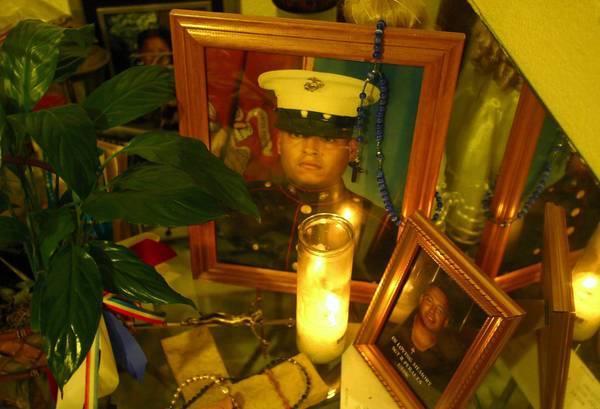RAMALLAH, West Bank — In the daily demonstrations here of solidarity with Gaza, a mix of sympathy and anguish, there is something else: growing identification with the Islamist fighters of Hamas and derision for the Palestinian Authority, which Washington considers the only viable partner for peace with Israel.
“Strike a blow on Tel Aviv!” proclaimed the lyrics of a new hit song blasting from shops and speakers at Monday’s demonstration, in a reference to Hamas rockets that made it nearly to Israel’s economic and cultural capital. “Don’t let the Zionists sleep! We don’t want a truce or a solution! Oh, Palestinians, you can be proud!”
Pop songs everywhere are filled with bravado and aggression. But this one reflects a widespread sentiment that does not augur well for President Mahmoud Abbas and his Palestinian Authority, which is rapidly losing credibility, even relevance. The Gaza truce talks in Cairo, involving Egypt, Turkey and Qatar, offer a telling tableau. The Palestinian leader seen there is not Mr. Abbas, but Khaled Meshal, the leader of the militant group Hamas, who seeks to speak for all Palestinians as his ideological brothers in the Muslim Brotherhood rise to power around the region.
Israel is also threatening Mr. Abbas, even hinting that it may give up on him, as he prepares to go to the United Nations General Assembly on Nov. 29 to try to upgrade the Palestinian status to that of a nonmember state. The Israelis consider this step an act of aggression, and even some Palestinians say it is somewhat beside the point at this stage.
“His people are being killed in Gaza, and he is sitting on his comfortable chair in Ramallah,” lamented Firas Katash, 20, a student who took part in the Ramallah demonstration.
For the United States, as for other countries hoping to promote a two-state solution to this century-old conflict, a more radicalized West Bank with a discredited Palestinian Authority would mean greater insecurity for Israel and increased opportunity for anti-Western forces to take root in a region where Islamism is on the rise.
Since Hamas, which won parliamentary elections in 2006, threw the Fatah-controlled authority out of Gaza a year later, Mr. Abbas has not set foot there. Yet he will be asking the world to recognize the two increasingly distinct entities as a unified state.
Manar Wadi, who works in an office in Ramallah, put the issue this way: “What is happening in Gaza makes the Palestinian Authority left behind and isolated. Now we see the other face of Hamas, and its popularity is rising. It makes us feel that the Palestinian Authority doesn’t offer a path to the future.”
In Cairo on Monday, Mr. Meshal seemed defiant and confident in his new role, daring the Israelis to invade Gaza as a sixth day of Israeli aerial assaults brought the death toll there to more than 100 people, many of them militants of Hamas and its affiliates. Rockets launched from Gaza hit southern Israel, causing some damage and panic, but no casualties, leaving the death toll there at three.
“Whoever started the war must end it,” Mr. Meshal said at a news conference. “If Israel wants a cease-fire brokered through Egypt, then that is possible. Escalation is also possible.”
Officials in the authority have been holding leadership meetings, staying in close touch with the talks in Cairo and issuing statements of solidarity. They have also sent a small medical delegation to Gaza and argue that there is a new opportunity to forge unity between the two feuding movements. But they are acutely aware of their problem.
“The most dangerous thing is the fact that what we could not do in negotiations, Hamas did with one rocket,” one official said, speaking on the condition of anonymity. “The people had such excitement seeing the occupiers run in panic. It’s a very dangerous message.”
Mr. Abbas, whose popularity has been on the decline as the Palestinian Authority faces economic difficulty and growing Israeli settlements, also ran into trouble not long before the Gaza fighting began when he seemed to give up on the Palestinian demand of a right of return to what is now Israel.
Many Palestinians believe that Israel launched its latest operation in Gaza to block the Palestinian Authority’s United Nations plans by embarrassing it. Israeli officials say that is ridiculous: the operation’s purpose is to stop the growing number of rockets being fired at their communities, and Israelis interrupted their deliberations over the United Nations bid to wage the military campaign.
But Israel says anything that does not involve direct negotiations is a waste of time. The government of Prime Minister Benjamin Netanyahu has repeatedly threatened to take severe retaliatory steps against the Palestinian Authority, including cutting off badly needed tax receipts to Palestinian coffers, should Mr. Abbas go ahead at the United Nations.
In a speech here on Sunday night at a Palestinian leadership meeting, Mr. Abbas repeated his determination to go to New York and ask for a change in status to that of nonmember state. He has chosen the symbolically significant date of Nov. 29, when the General Assembly voted in 1947 to divide this land into two states, one Jewish and the other Palestinian Arab.
The United States has asked Mr. Abbas not to do so, but instead to resume direct negotiations with Israel, which have essentially been frozen since 2008.










